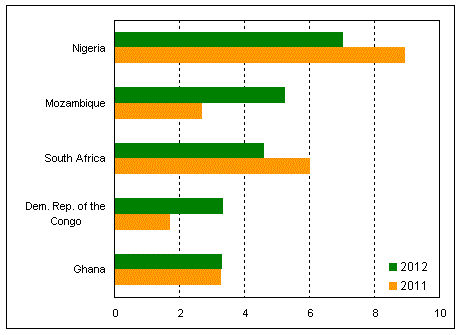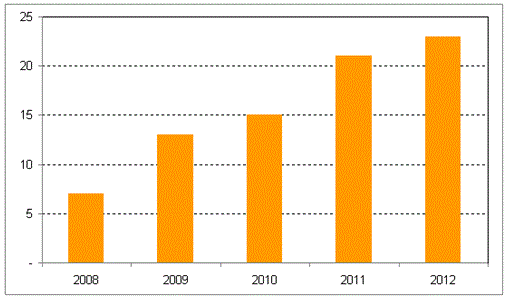Foreign direct investment (FDI) flows to African countries increased by 5 per cent to US$50 billion in 2012 even as global FDI fell by 18 per cent, UNCTAD’s annual survey of investment trends reports.
The World Investment Report 20131, subtitled Global Value Chains: Investment and Trade for Development, was released today.
As reflected in the FDI make-up of the top recipient countries (figure 1), investment in extractive industries remains the most important driver of FDI to Africa, the study notes. However, projects in manufacturing and services that aim at serving Africa’s growing consumer markets also registered investment increases (figure 2).
The region of North Africa is beginning to see signs of a revival in cross-border investment activities, after declines rooted in the area’s political turmoil in 2011. FDI flows to North Africa increased by 35 per cent to $11.5 billion in 2012, the World Investment Report notes. Much of this increase was accounted for by a turnaround in Egypt, where inflows climbed from a net divestment of $0.5 billion in 2011 to a positive $2.8 billion in 2012. The report notes that the 2012 figure is still much lower than the levels reached in Egypt before 2011.
FDI flows to West Africa declined by 5 per cent to $16.8 billion, the report reveals. Of investment channelled to the two major oil-producing countries of the region, FDI to Ghana remained stable at $3.3 billion, but inflows to Nigeria declined by 21 per cent to $7.0 billion, accounting for much of the diminished flows to the region. On the positive side, mining interests in Mauritania helped that country’s inflows double to $1.2 billion, the report says.
Central Africa saw its inflows rise to $10 billion, a record high, maintaining a trend of increasing FDI since 2010. Natural resources continue to attract investment from mining transnational corporations (TNCs). For example, significant FDI was targeted at the expansion of the copper-cobalt Tenke Fungurume mine (Democratic Republic of the Congo).
Energy resources such as recently discovered gas reserves in the United Republic of Tanzania and oil fields in Uganda drew increased FDI to East Africa. As a result, inflows to the region expanded from $4.5 billion in 2011 to $6.3 billion in 2012, the report says.
FDI flows to Southern Africa fell sharply, however, from $8.7 billion in 2011 to $5.4 billion in 2012, even as some countries saw substantial increases. Inflows to Mozambique, for example, doubled to $5.2 billion, attracted by the country’s huge offshore gas deposits. Meanwhile, Angola registered a third successive year of decline in FDI. Investment to that country fell by $6.9 billion. Inflows to South Africa, which have tended to fluctuate greatly in recent years, dropped by 24 per cent in 2012, to $4.6 billion. By contrast, FDI outflows from South Africa rebounded sharply to $4.4 billion, returning the country to the position of largest source country of FDI in Africa. South African companies were active in acquiring operations in industries such as mining, wholesale, and healthcare during 2012.
While it is apparent that natural resources are still the mainstay of FDI flows to Africa, the report notes that FDI in consumer-oriented manufacturing and services is beginning to climb, reflecting the growing purchasing power of the continent’s emerging middle class. Between 2008 and 2012, the share of consumer-related industries in the value of greenfield investment projects in Africa grew from 7 per cent of the total to 23 per cent (figure 2). Greenfield investment is investment in businesses or economic sectors that are new to a given recipient country.
In terms of sources of FDI, TNCs from emerging markets are increasingly active in Africa, the report notes. Measured by FDI stock, Malaysia, South Africa, China and India (in that order) are the largest developing-country investors in Africa.
FDI outflows from African countries almost tripled in 2012, to $14 billion, the report says. Unlike inflows, outflows increased in all African regions, resulting in a record total.
Figure 1. Africa: Top 5 recipients of FDI inflows, 2011 and 2012
(billions of US dollars)
Source: UNCTAD, World Investment Report 2013.
Figure 2. Share of consumer-related FDI greenfield projects in total value of FDI greenfield projects in Africa, 2008–2012
(as percentages)
Source: UNCTAD, World Investment Report 2013.


